Project Management and Risk Analysis Report - Continuous Monitoring
VerifiedAdded on 2023/01/10
|16
|4912
|5
Report
AI Summary
This report delves into the multifaceted realm of project management, focusing on a continuous pressure monitoring technology project aimed at identifying and mitigating pressure ulcers in Cornwall. It begins by defining the project scope, outlining the project life cycle, and exploring various methodologies like Agile, Scrum, Lean, Waterfall, and Six Sigma. The report then identifies different types of risks, including scheduling, technical, resource, and financial risks, along with appropriate risk management strategies such as avoidance, mitigation, transfer, and acceptance. Furthermore, it utilizes the Mendelow matrix to analyze stakeholder roles and responsibilities, emphasizing the significance of stakeholder engagement. The report also examines legal and non-legal solutions for minimizing project risks and explores how team development theories, specifically Tuckman's stages and McClelland's needs theory, can support team performance and project goal attainment. Overall, the report provides a comprehensive overview of project management principles and their practical application in a healthcare context.
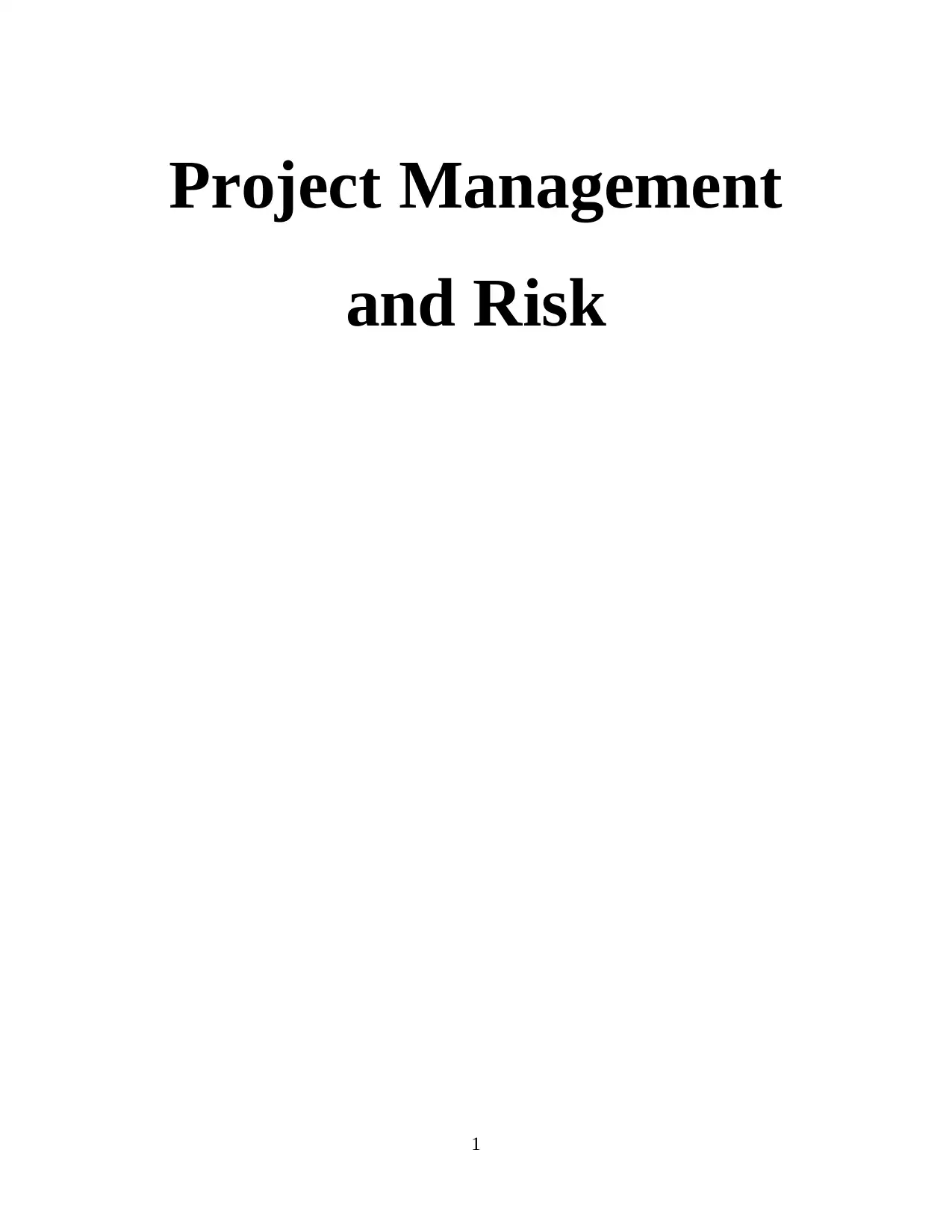
Project Management
and Risk
1
and Risk
1
Paraphrase This Document
Need a fresh take? Get an instant paraphrase of this document with our AI Paraphraser
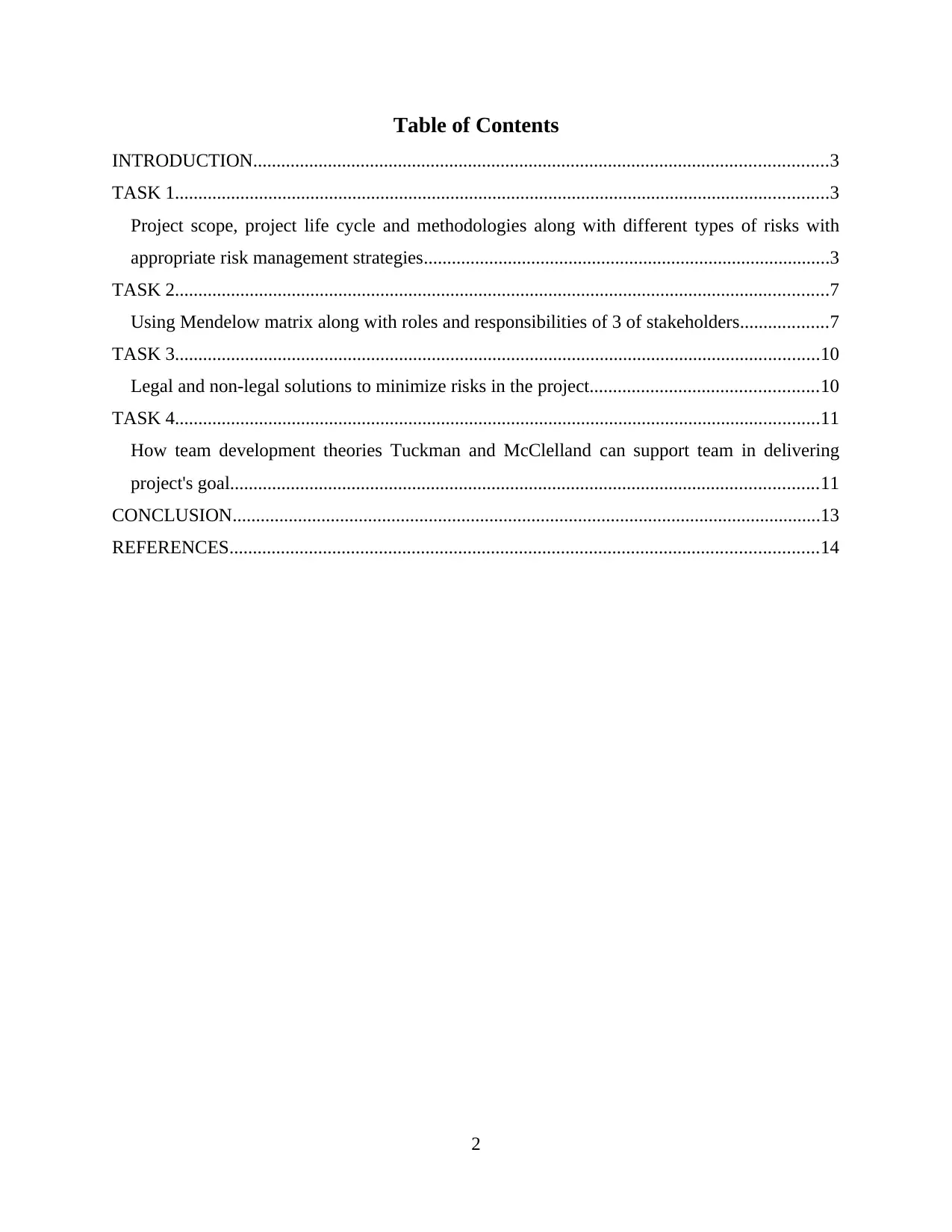
Table of Contents
INTRODUCTION...........................................................................................................................3
TASK 1............................................................................................................................................3
Project scope, project life cycle and methodologies along with different types of risks with
appropriate risk management strategies.......................................................................................3
TASK 2............................................................................................................................................7
Using Mendelow matrix along with roles and responsibilities of 3 of stakeholders...................7
TASK 3..........................................................................................................................................10
Legal and non-legal solutions to minimize risks in the project.................................................10
TASK 4..........................................................................................................................................11
How team development theories Tuckman and McClelland can support team in delivering
project's goal..............................................................................................................................11
CONCLUSION..............................................................................................................................13
REFERENCES..............................................................................................................................14
2
INTRODUCTION...........................................................................................................................3
TASK 1............................................................................................................................................3
Project scope, project life cycle and methodologies along with different types of risks with
appropriate risk management strategies.......................................................................................3
TASK 2............................................................................................................................................7
Using Mendelow matrix along with roles and responsibilities of 3 of stakeholders...................7
TASK 3..........................................................................................................................................10
Legal and non-legal solutions to minimize risks in the project.................................................10
TASK 4..........................................................................................................................................11
How team development theories Tuckman and McClelland can support team in delivering
project's goal..............................................................................................................................11
CONCLUSION..............................................................................................................................13
REFERENCES..............................................................................................................................14
2
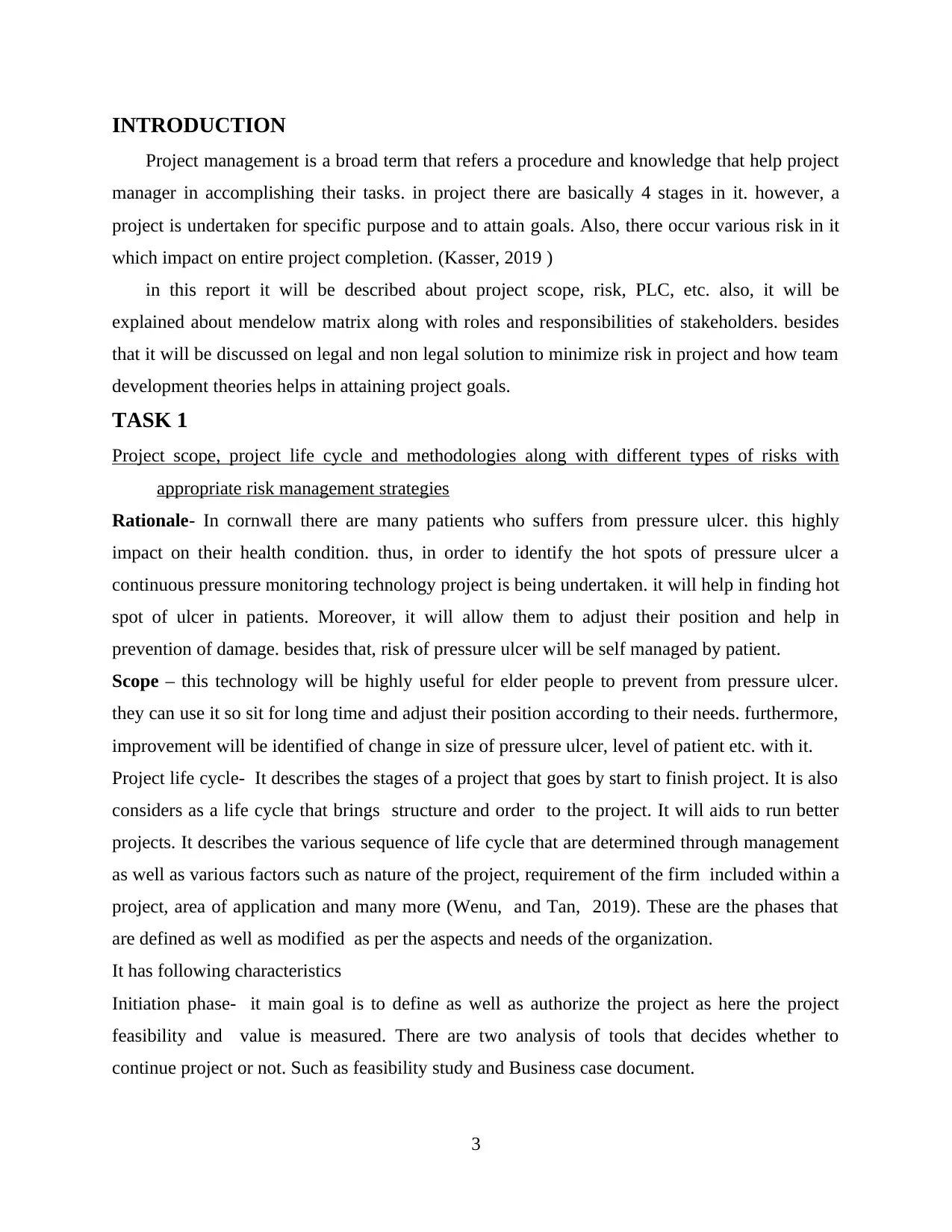
INTRODUCTION
Project management is a broad term that refers a procedure and knowledge that help project
manager in accomplishing their tasks. in project there are basically 4 stages in it. however, a
project is undertaken for specific purpose and to attain goals. Also, there occur various risk in it
which impact on entire project completion. (Kasser, 2019 )
in this report it will be described about project scope, risk, PLC, etc. also, it will be
explained about mendelow matrix along with roles and responsibilities of stakeholders. besides
that it will be discussed on legal and non legal solution to minimize risk in project and how team
development theories helps in attaining project goals.
TASK 1
Project scope, project life cycle and methodologies along with different types of risks with
appropriate risk management strategies
Rationale- In cornwall there are many patients who suffers from pressure ulcer. this highly
impact on their health condition. thus, in order to identify the hot spots of pressure ulcer a
continuous pressure monitoring technology project is being undertaken. it will help in finding hot
spot of ulcer in patients. Moreover, it will allow them to adjust their position and help in
prevention of damage. besides that, risk of pressure ulcer will be self managed by patient.
Scope – this technology will be highly useful for elder people to prevent from pressure ulcer.
they can use it so sit for long time and adjust their position according to their needs. furthermore,
improvement will be identified of change in size of pressure ulcer, level of patient etc. with it.
Project life cycle- It describes the stages of a project that goes by start to finish project. It is also
considers as a life cycle that brings structure and order to the project. It will aids to run better
projects. It describes the various sequence of life cycle that are determined through management
as well as various factors such as nature of the project, requirement of the firm included within a
project, area of application and many more (Wenu, and Tan, 2019). These are the phases that
are defined as well as modified as per the aspects and needs of the organization.
It has following characteristics
Initiation phase- it main goal is to define as well as authorize the project as here the project
feasibility and value is measured. There are two analysis of tools that decides whether to
continue project or not. Such as feasibility study and Business case document.
3
Project management is a broad term that refers a procedure and knowledge that help project
manager in accomplishing their tasks. in project there are basically 4 stages in it. however, a
project is undertaken for specific purpose and to attain goals. Also, there occur various risk in it
which impact on entire project completion. (Kasser, 2019 )
in this report it will be described about project scope, risk, PLC, etc. also, it will be
explained about mendelow matrix along with roles and responsibilities of stakeholders. besides
that it will be discussed on legal and non legal solution to minimize risk in project and how team
development theories helps in attaining project goals.
TASK 1
Project scope, project life cycle and methodologies along with different types of risks with
appropriate risk management strategies
Rationale- In cornwall there are many patients who suffers from pressure ulcer. this highly
impact on their health condition. thus, in order to identify the hot spots of pressure ulcer a
continuous pressure monitoring technology project is being undertaken. it will help in finding hot
spot of ulcer in patients. Moreover, it will allow them to adjust their position and help in
prevention of damage. besides that, risk of pressure ulcer will be self managed by patient.
Scope – this technology will be highly useful for elder people to prevent from pressure ulcer.
they can use it so sit for long time and adjust their position according to their needs. furthermore,
improvement will be identified of change in size of pressure ulcer, level of patient etc. with it.
Project life cycle- It describes the stages of a project that goes by start to finish project. It is also
considers as a life cycle that brings structure and order to the project. It will aids to run better
projects. It describes the various sequence of life cycle that are determined through management
as well as various factors such as nature of the project, requirement of the firm included within a
project, area of application and many more (Wenu, and Tan, 2019). These are the phases that
are defined as well as modified as per the aspects and needs of the organization.
It has following characteristics
Initiation phase- it main goal is to define as well as authorize the project as here the project
feasibility and value is measured. There are two analysis of tools that decides whether to
continue project or not. Such as feasibility study and Business case document.
3
⊘ This is a preview!⊘
Do you want full access?
Subscribe today to unlock all pages.

Trusted by 1+ million students worldwide
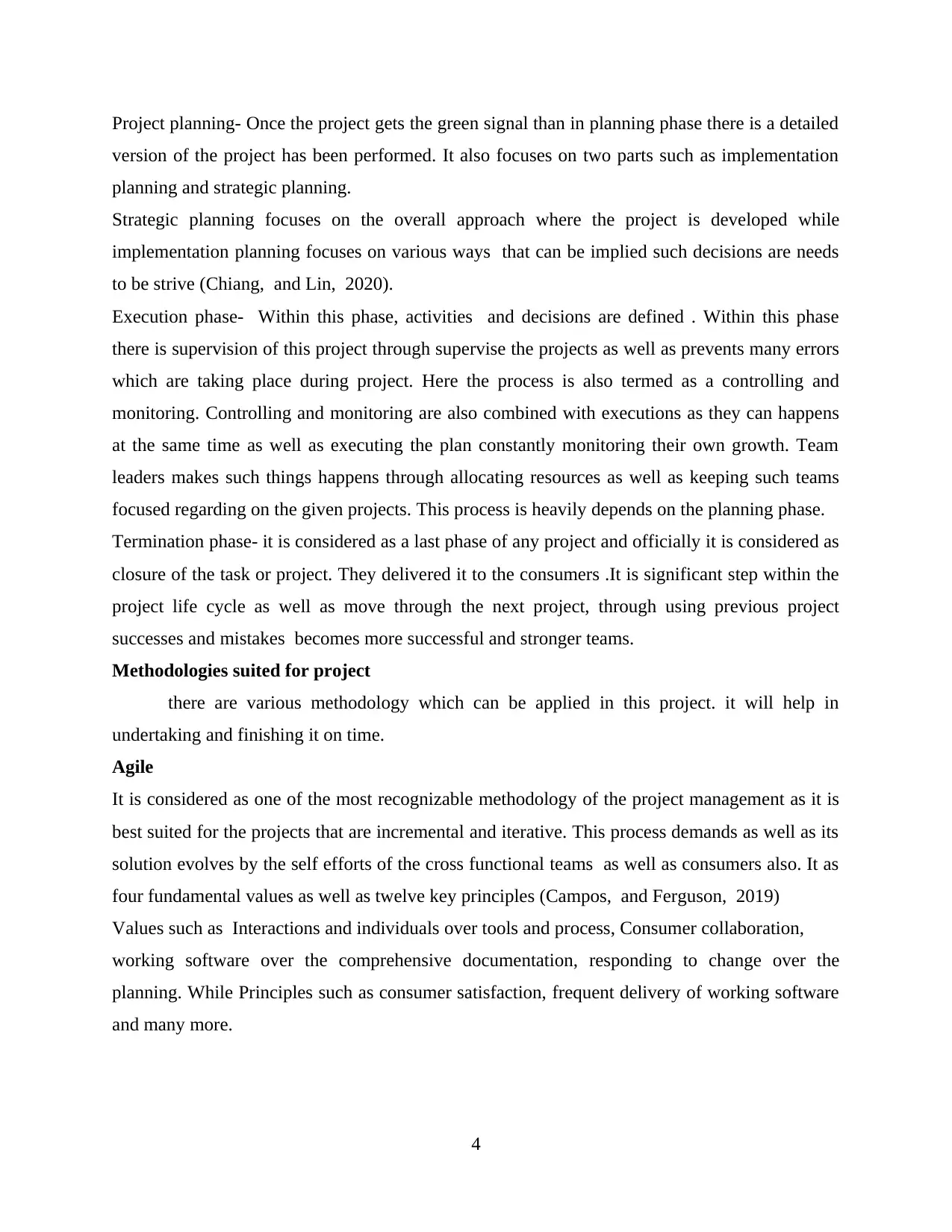
Project planning- Once the project gets the green signal than in planning phase there is a detailed
version of the project has been performed. It also focuses on two parts such as implementation
planning and strategic planning.
Strategic planning focuses on the overall approach where the project is developed while
implementation planning focuses on various ways that can be implied such decisions are needs
to be strive (Chiang, and Lin, 2020).
Execution phase- Within this phase, activities and decisions are defined . Within this phase
there is supervision of this project through supervise the projects as well as prevents many errors
which are taking place during project. Here the process is also termed as a controlling and
monitoring. Controlling and monitoring are also combined with executions as they can happens
at the same time as well as executing the plan constantly monitoring their own growth. Team
leaders makes such things happens through allocating resources as well as keeping such teams
focused regarding on the given projects. This process is heavily depends on the planning phase.
Termination phase- it is considered as a last phase of any project and officially it is considered as
closure of the task or project. They delivered it to the consumers .It is significant step within the
project life cycle as well as move through the next project, through using previous project
successes and mistakes becomes more successful and stronger teams.
Methodologies suited for project
there are various methodology which can be applied in this project. it will help in
undertaking and finishing it on time.
Agile
It is considered as one of the most recognizable methodology of the project management as it is
best suited for the projects that are incremental and iterative. This process demands as well as its
solution evolves by the self efforts of the cross functional teams as well as consumers also. It as
four fundamental values as well as twelve key principles (Campos, and Ferguson, 2019)
Values such as Interactions and individuals over tools and process, Consumer collaboration,
working software over the comprehensive documentation, responding to change over the
planning. While Principles such as consumer satisfaction, frequent delivery of working software
and many more.
4
version of the project has been performed. It also focuses on two parts such as implementation
planning and strategic planning.
Strategic planning focuses on the overall approach where the project is developed while
implementation planning focuses on various ways that can be implied such decisions are needs
to be strive (Chiang, and Lin, 2020).
Execution phase- Within this phase, activities and decisions are defined . Within this phase
there is supervision of this project through supervise the projects as well as prevents many errors
which are taking place during project. Here the process is also termed as a controlling and
monitoring. Controlling and monitoring are also combined with executions as they can happens
at the same time as well as executing the plan constantly monitoring their own growth. Team
leaders makes such things happens through allocating resources as well as keeping such teams
focused regarding on the given projects. This process is heavily depends on the planning phase.
Termination phase- it is considered as a last phase of any project and officially it is considered as
closure of the task or project. They delivered it to the consumers .It is significant step within the
project life cycle as well as move through the next project, through using previous project
successes and mistakes becomes more successful and stronger teams.
Methodologies suited for project
there are various methodology which can be applied in this project. it will help in
undertaking and finishing it on time.
Agile
It is considered as one of the most recognizable methodology of the project management as it is
best suited for the projects that are incremental and iterative. This process demands as well as its
solution evolves by the self efforts of the cross functional teams as well as consumers also. It as
four fundamental values as well as twelve key principles (Campos, and Ferguson, 2019)
Values such as Interactions and individuals over tools and process, Consumer collaboration,
working software over the comprehensive documentation, responding to change over the
planning. While Principles such as consumer satisfaction, frequent delivery of working software
and many more.
4
Paraphrase This Document
Need a fresh take? Get an instant paraphrase of this document with our AI Paraphraser
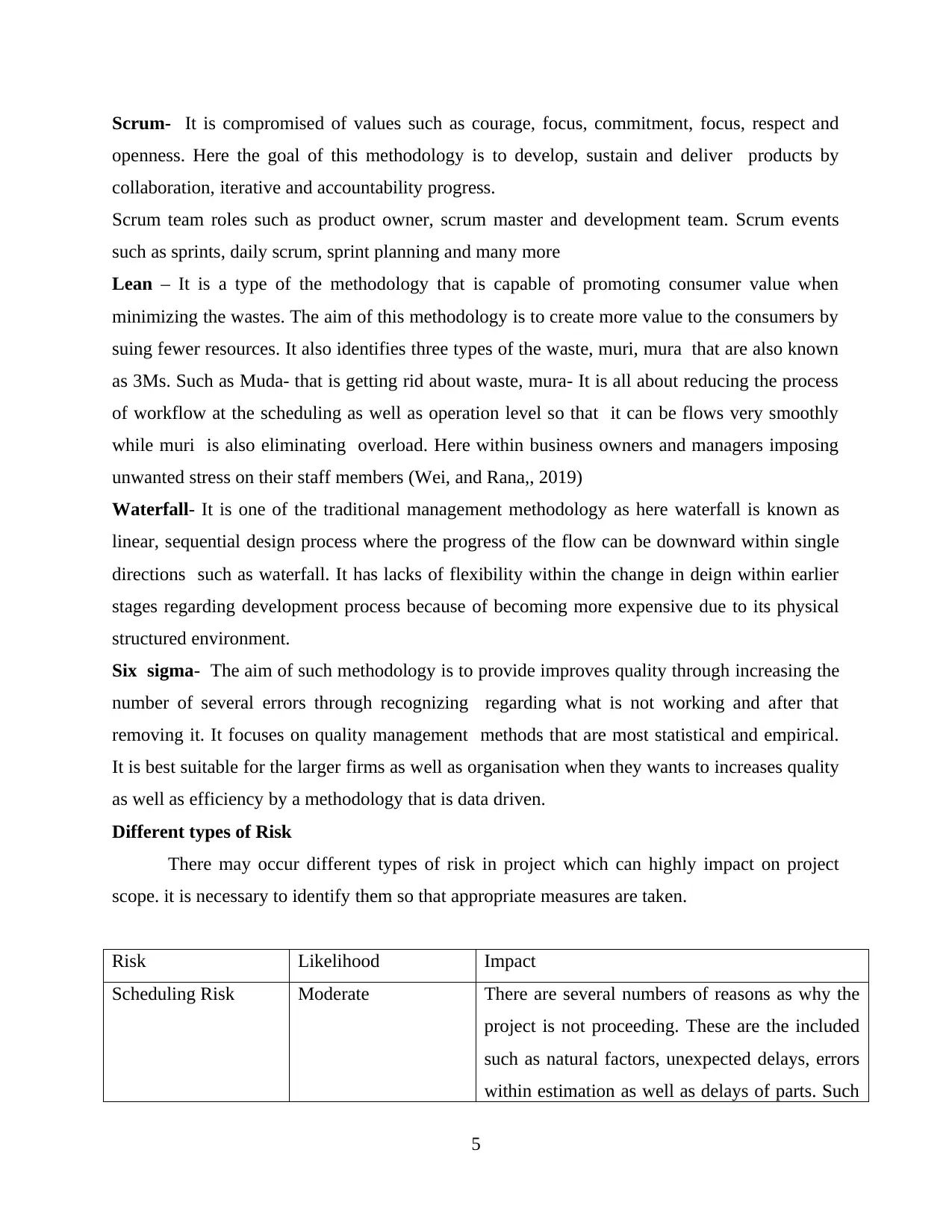
Scrum- It is compromised of values such as courage, focus, commitment, focus, respect and
openness. Here the goal of this methodology is to develop, sustain and deliver products by
collaboration, iterative and accountability progress.
Scrum team roles such as product owner, scrum master and development team. Scrum events
such as sprints, daily scrum, sprint planning and many more
Lean – It is a type of the methodology that is capable of promoting consumer value when
minimizing the wastes. The aim of this methodology is to create more value to the consumers by
suing fewer resources. It also identifies three types of the waste, muri, mura that are also known
as 3Ms. Such as Muda- that is getting rid about waste, mura- It is all about reducing the process
of workflow at the scheduling as well as operation level so that it can be flows very smoothly
while muri is also eliminating overload. Here within business owners and managers imposing
unwanted stress on their staff members (Wei, and Rana,, 2019)
Waterfall- It is one of the traditional management methodology as here waterfall is known as
linear, sequential design process where the progress of the flow can be downward within single
directions such as waterfall. It has lacks of flexibility within the change in deign within earlier
stages regarding development process because of becoming more expensive due to its physical
structured environment.
Six sigma- The aim of such methodology is to provide improves quality through increasing the
number of several errors through recognizing regarding what is not working and after that
removing it. It focuses on quality management methods that are most statistical and empirical.
It is best suitable for the larger firms as well as organisation when they wants to increases quality
as well as efficiency by a methodology that is data driven.
Different types of Risk
There may occur different types of risk in project which can highly impact on project
scope. it is necessary to identify them so that appropriate measures are taken.
Risk Likelihood Impact
Scheduling Risk Moderate There are several numbers of reasons as why the
project is not proceeding. These are the included
such as natural factors, unexpected delays, errors
within estimation as well as delays of parts. Such
5
openness. Here the goal of this methodology is to develop, sustain and deliver products by
collaboration, iterative and accountability progress.
Scrum team roles such as product owner, scrum master and development team. Scrum events
such as sprints, daily scrum, sprint planning and many more
Lean – It is a type of the methodology that is capable of promoting consumer value when
minimizing the wastes. The aim of this methodology is to create more value to the consumers by
suing fewer resources. It also identifies three types of the waste, muri, mura that are also known
as 3Ms. Such as Muda- that is getting rid about waste, mura- It is all about reducing the process
of workflow at the scheduling as well as operation level so that it can be flows very smoothly
while muri is also eliminating overload. Here within business owners and managers imposing
unwanted stress on their staff members (Wei, and Rana,, 2019)
Waterfall- It is one of the traditional management methodology as here waterfall is known as
linear, sequential design process where the progress of the flow can be downward within single
directions such as waterfall. It has lacks of flexibility within the change in deign within earlier
stages regarding development process because of becoming more expensive due to its physical
structured environment.
Six sigma- The aim of such methodology is to provide improves quality through increasing the
number of several errors through recognizing regarding what is not working and after that
removing it. It focuses on quality management methods that are most statistical and empirical.
It is best suitable for the larger firms as well as organisation when they wants to increases quality
as well as efficiency by a methodology that is data driven.
Different types of Risk
There may occur different types of risk in project which can highly impact on project
scope. it is necessary to identify them so that appropriate measures are taken.
Risk Likelihood Impact
Scheduling Risk Moderate There are several numbers of reasons as why the
project is not proceeding. These are the included
such as natural factors, unexpected delays, errors
within estimation as well as delays of parts. Such
5
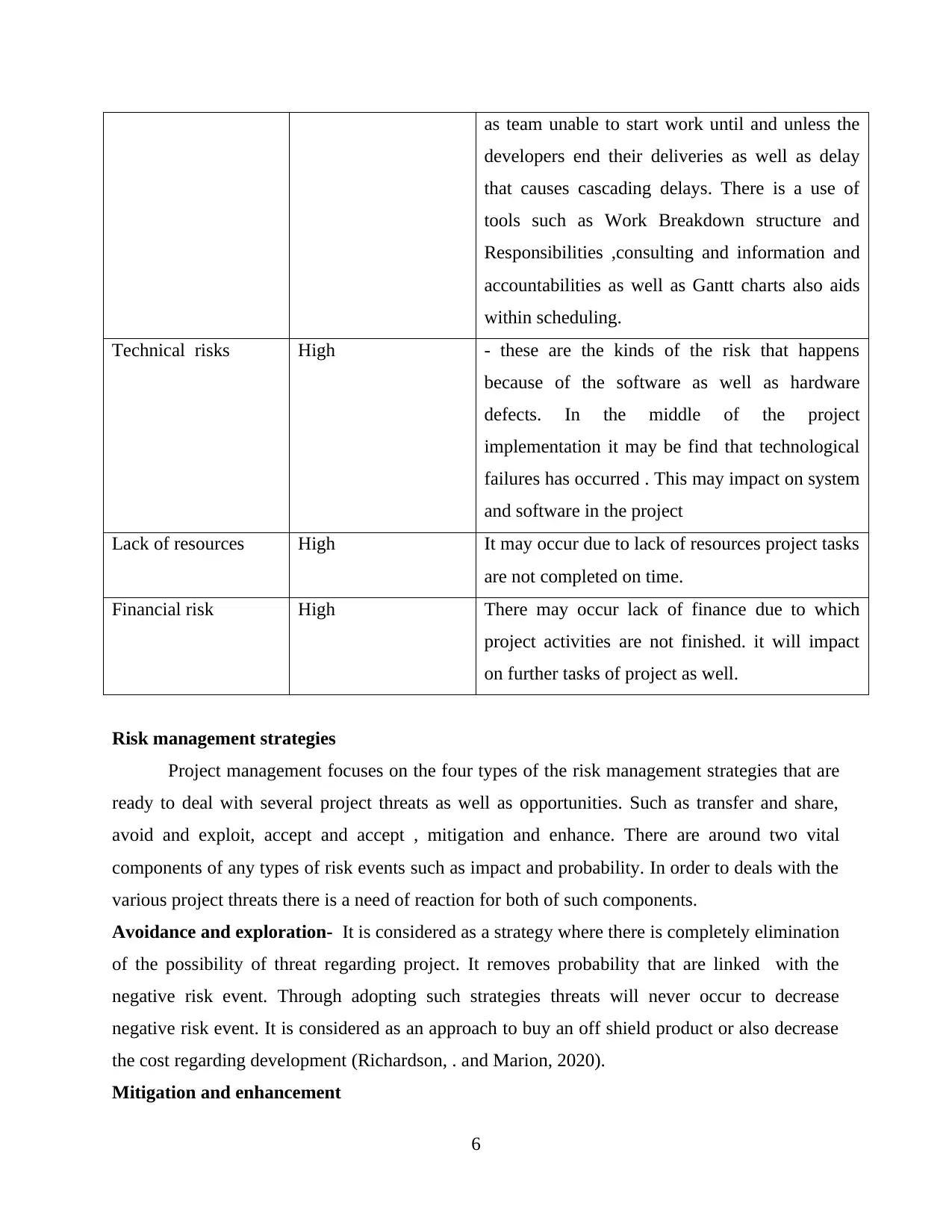
as team unable to start work until and unless the
developers end their deliveries as well as delay
that causes cascading delays. There is a use of
tools such as Work Breakdown structure and
Responsibilities ,consulting and information and
accountabilities as well as Gantt charts also aids
within scheduling.
Technical risks High - these are the kinds of the risk that happens
because of the software as well as hardware
defects. In the middle of the project
implementation it may be find that technological
failures has occurred . This may impact on system
and software in the project
Lack of resources High It may occur due to lack of resources project tasks
are not completed on time.
Financial risk High There may occur lack of finance due to which
project activities are not finished. it will impact
on further tasks of project as well.
Risk management strategies
Project management focuses on the four types of the risk management strategies that are
ready to deal with several project threats as well as opportunities. Such as transfer and share,
avoid and exploit, accept and accept , mitigation and enhance. There are around two vital
components of any types of risk events such as impact and probability. In order to deals with the
various project threats there is a need of reaction for both of such components.
Avoidance and exploration- It is considered as a strategy where there is completely elimination
of the possibility of threat regarding project. It removes probability that are linked with the
negative risk event. Through adopting such strategies threats will never occur to decrease
negative risk event. It is considered as an approach to buy an off shield product or also decrease
the cost regarding development (Richardson, . and Marion, 2020).
Mitigation and enhancement
6
developers end their deliveries as well as delay
that causes cascading delays. There is a use of
tools such as Work Breakdown structure and
Responsibilities ,consulting and information and
accountabilities as well as Gantt charts also aids
within scheduling.
Technical risks High - these are the kinds of the risk that happens
because of the software as well as hardware
defects. In the middle of the project
implementation it may be find that technological
failures has occurred . This may impact on system
and software in the project
Lack of resources High It may occur due to lack of resources project tasks
are not completed on time.
Financial risk High There may occur lack of finance due to which
project activities are not finished. it will impact
on further tasks of project as well.
Risk management strategies
Project management focuses on the four types of the risk management strategies that are
ready to deal with several project threats as well as opportunities. Such as transfer and share,
avoid and exploit, accept and accept , mitigation and enhance. There are around two vital
components of any types of risk events such as impact and probability. In order to deals with the
various project threats there is a need of reaction for both of such components.
Avoidance and exploration- It is considered as a strategy where there is completely elimination
of the possibility of threat regarding project. It removes probability that are linked with the
negative risk event. Through adopting such strategies threats will never occur to decrease
negative risk event. It is considered as an approach to buy an off shield product or also decrease
the cost regarding development (Richardson, . and Marion, 2020).
Mitigation and enhancement
6
⊘ This is a preview!⊘
Do you want full access?
Subscribe today to unlock all pages.

Trusted by 1+ million students worldwide
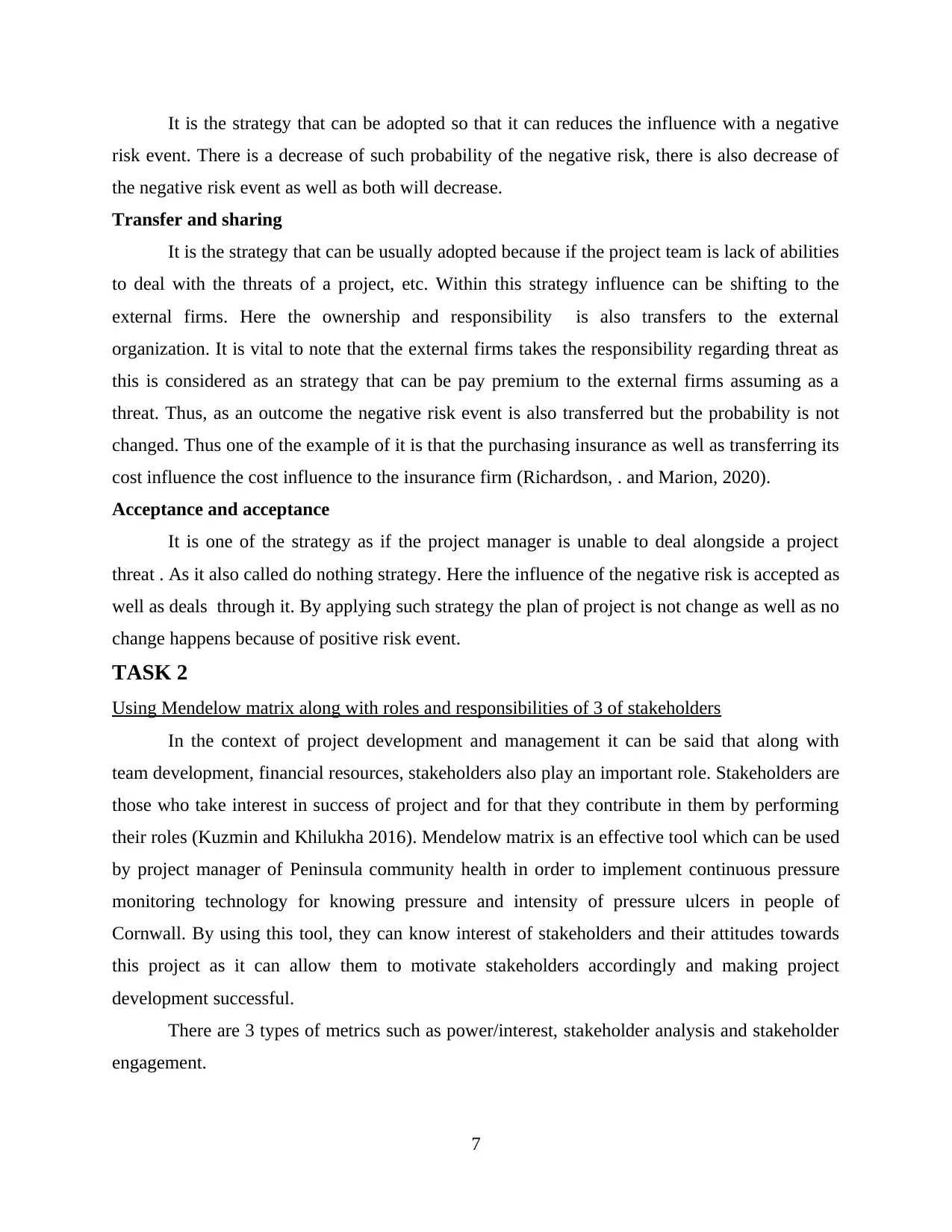
It is the strategy that can be adopted so that it can reduces the influence with a negative
risk event. There is a decrease of such probability of the negative risk, there is also decrease of
the negative risk event as well as both will decrease.
Transfer and sharing
It is the strategy that can be usually adopted because if the project team is lack of abilities
to deal with the threats of a project, etc. Within this strategy influence can be shifting to the
external firms. Here the ownership and responsibility is also transfers to the external
organization. It is vital to note that the external firms takes the responsibility regarding threat as
this is considered as an strategy that can be pay premium to the external firms assuming as a
threat. Thus, as an outcome the negative risk event is also transferred but the probability is not
changed. Thus one of the example of it is that the purchasing insurance as well as transferring its
cost influence the cost influence to the insurance firm (Richardson, . and Marion, 2020).
Acceptance and acceptance
It is one of the strategy as if the project manager is unable to deal alongside a project
threat . As it also called do nothing strategy. Here the influence of the negative risk is accepted as
well as deals through it. By applying such strategy the plan of project is not change as well as no
change happens because of positive risk event.
TASK 2
Using Mendelow matrix along with roles and responsibilities of 3 of stakeholders
In the context of project development and management it can be said that along with
team development, financial resources, stakeholders also play an important role. Stakeholders are
those who take interest in success of project and for that they contribute in them by performing
their roles (Kuzmin and Khilukha 2016). Mendelow matrix is an effective tool which can be used
by project manager of Peninsula community health in order to implement continuous pressure
monitoring technology for knowing pressure and intensity of pressure ulcers in people of
Cornwall. By using this tool, they can know interest of stakeholders and their attitudes towards
this project as it can allow them to motivate stakeholders accordingly and making project
development successful.
There are 3 types of metrics such as power/interest, stakeholder analysis and stakeholder
engagement.
7
risk event. There is a decrease of such probability of the negative risk, there is also decrease of
the negative risk event as well as both will decrease.
Transfer and sharing
It is the strategy that can be usually adopted because if the project team is lack of abilities
to deal with the threats of a project, etc. Within this strategy influence can be shifting to the
external firms. Here the ownership and responsibility is also transfers to the external
organization. It is vital to note that the external firms takes the responsibility regarding threat as
this is considered as an strategy that can be pay premium to the external firms assuming as a
threat. Thus, as an outcome the negative risk event is also transferred but the probability is not
changed. Thus one of the example of it is that the purchasing insurance as well as transferring its
cost influence the cost influence to the insurance firm (Richardson, . and Marion, 2020).
Acceptance and acceptance
It is one of the strategy as if the project manager is unable to deal alongside a project
threat . As it also called do nothing strategy. Here the influence of the negative risk is accepted as
well as deals through it. By applying such strategy the plan of project is not change as well as no
change happens because of positive risk event.
TASK 2
Using Mendelow matrix along with roles and responsibilities of 3 of stakeholders
In the context of project development and management it can be said that along with
team development, financial resources, stakeholders also play an important role. Stakeholders are
those who take interest in success of project and for that they contribute in them by performing
their roles (Kuzmin and Khilukha 2016). Mendelow matrix is an effective tool which can be used
by project manager of Peninsula community health in order to implement continuous pressure
monitoring technology for knowing pressure and intensity of pressure ulcers in people of
Cornwall. By using this tool, they can know interest of stakeholders and their attitudes towards
this project as it can allow them to motivate stakeholders accordingly and making project
development successful.
There are 3 types of metrics such as power/interest, stakeholder analysis and stakeholder
engagement.
7
Paraphrase This Document
Need a fresh take? Get an instant paraphrase of this document with our AI Paraphraser
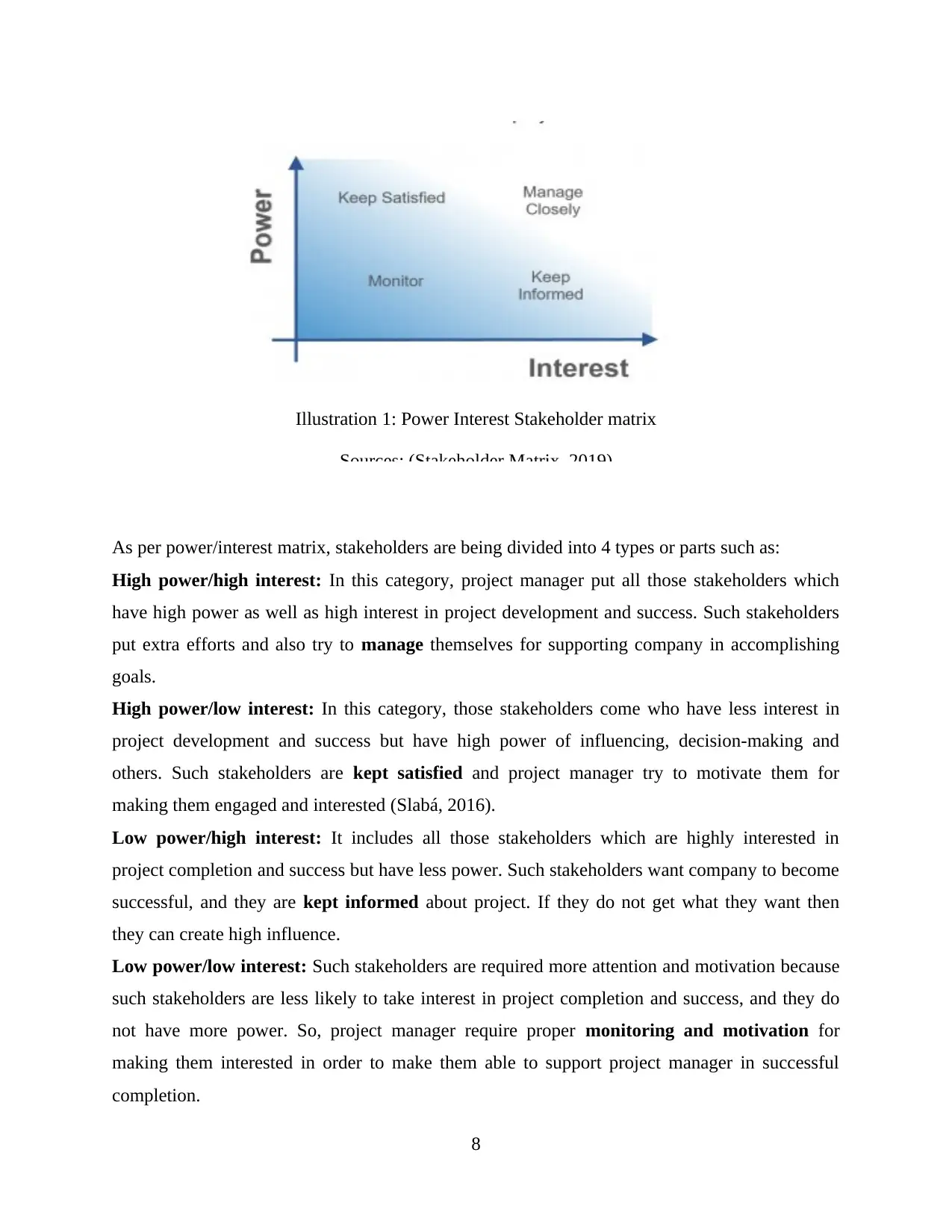
As per power/interest matrix, stakeholders are being divided into 4 types or parts such as:
High power/high interest: In this category, project manager put all those stakeholders which
have high power as well as high interest in project development and success. Such stakeholders
put extra efforts and also try to manage themselves for supporting company in accomplishing
goals.
High power/low interest: In this category, those stakeholders come who have less interest in
project development and success but have high power of influencing, decision-making and
others. Such stakeholders are kept satisfied and project manager try to motivate them for
making them engaged and interested (Slabá, 2016).
Low power/high interest: It includes all those stakeholders which are highly interested in
project completion and success but have less power. Such stakeholders want company to become
successful, and they are kept informed about project. If they do not get what they want then
they can create high influence.
Low power/low interest: Such stakeholders are required more attention and motivation because
such stakeholders are less likely to take interest in project completion and success, and they do
not have more power. So, project manager require proper monitoring and motivation for
making them interested in order to make them able to support project manager in successful
completion.
8
Illustration 1: Power Interest Stakeholder matrix
Sources: (Stakeholder Matrix, 2019)
High power/high interest: In this category, project manager put all those stakeholders which
have high power as well as high interest in project development and success. Such stakeholders
put extra efforts and also try to manage themselves for supporting company in accomplishing
goals.
High power/low interest: In this category, those stakeholders come who have less interest in
project development and success but have high power of influencing, decision-making and
others. Such stakeholders are kept satisfied and project manager try to motivate them for
making them engaged and interested (Slabá, 2016).
Low power/high interest: It includes all those stakeholders which are highly interested in
project completion and success but have less power. Such stakeholders want company to become
successful, and they are kept informed about project. If they do not get what they want then
they can create high influence.
Low power/low interest: Such stakeholders are required more attention and motivation because
such stakeholders are less likely to take interest in project completion and success, and they do
not have more power. So, project manager require proper monitoring and motivation for
making them interested in order to make them able to support project manager in successful
completion.
8
Illustration 1: Power Interest Stakeholder matrix
Sources: (Stakeholder Matrix, 2019)
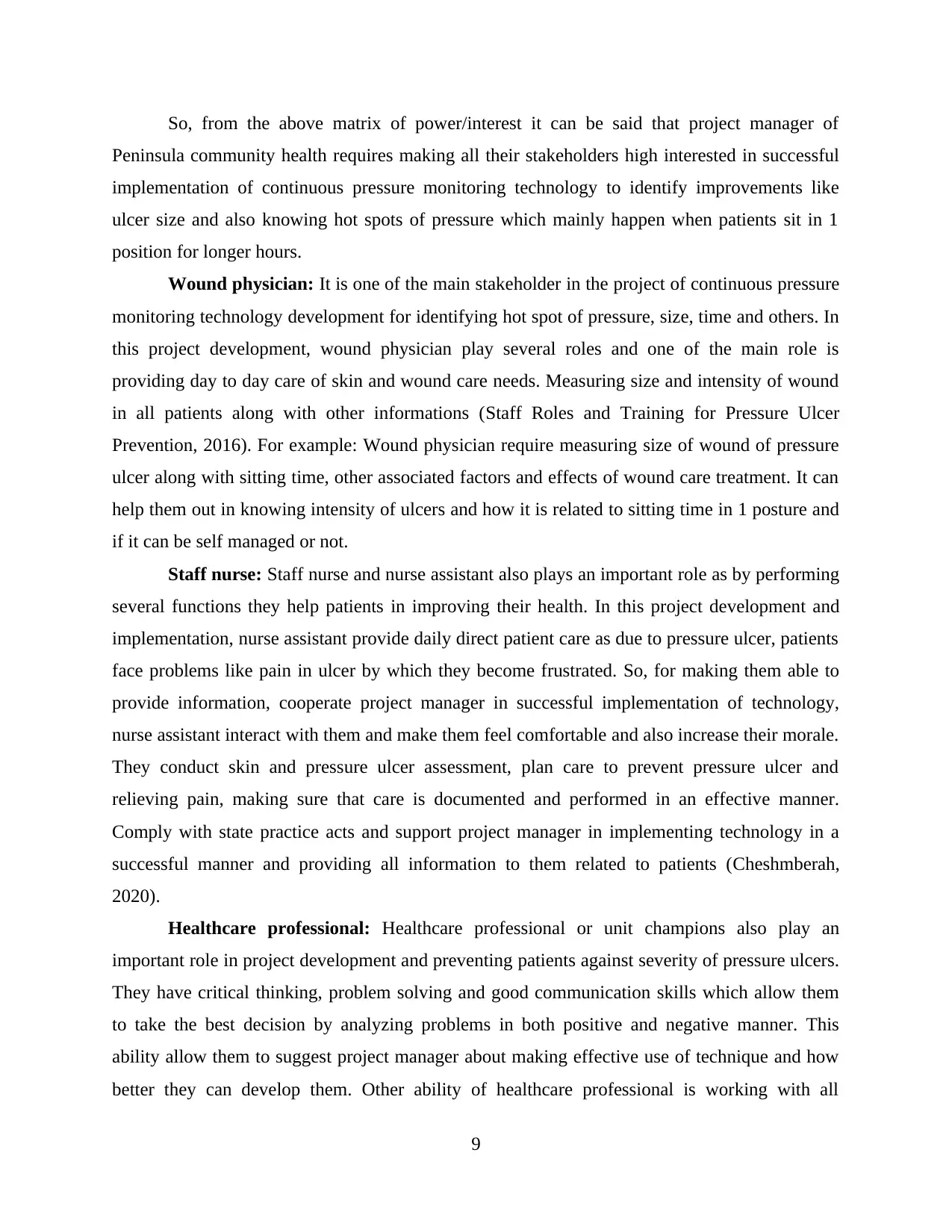
So, from the above matrix of power/interest it can be said that project manager of
Peninsula community health requires making all their stakeholders high interested in successful
implementation of continuous pressure monitoring technology to identify improvements like
ulcer size and also knowing hot spots of pressure which mainly happen when patients sit in 1
position for longer hours.
Wound physician: It is one of the main stakeholder in the project of continuous pressure
monitoring technology development for identifying hot spot of pressure, size, time and others. In
this project development, wound physician play several roles and one of the main role is
providing day to day care of skin and wound care needs. Measuring size and intensity of wound
in all patients along with other informations (Staff Roles and Training for Pressure Ulcer
Prevention, 2016). For example: Wound physician require measuring size of wound of pressure
ulcer along with sitting time, other associated factors and effects of wound care treatment. It can
help them out in knowing intensity of ulcers and how it is related to sitting time in 1 posture and
if it can be self managed or not.
Staff nurse: Staff nurse and nurse assistant also plays an important role as by performing
several functions they help patients in improving their health. In this project development and
implementation, nurse assistant provide daily direct patient care as due to pressure ulcer, patients
face problems like pain in ulcer by which they become frustrated. So, for making them able to
provide information, cooperate project manager in successful implementation of technology,
nurse assistant interact with them and make them feel comfortable and also increase their morale.
They conduct skin and pressure ulcer assessment, plan care to prevent pressure ulcer and
relieving pain, making sure that care is documented and performed in an effective manner.
Comply with state practice acts and support project manager in implementing technology in a
successful manner and providing all information to them related to patients (Cheshmberah,
2020).
Healthcare professional: Healthcare professional or unit champions also play an
important role in project development and preventing patients against severity of pressure ulcers.
They have critical thinking, problem solving and good communication skills which allow them
to take the best decision by analyzing problems in both positive and negative manner. This
ability allow them to suggest project manager about making effective use of technique and how
better they can develop them. Other ability of healthcare professional is working with all
9
Peninsula community health requires making all their stakeholders high interested in successful
implementation of continuous pressure monitoring technology to identify improvements like
ulcer size and also knowing hot spots of pressure which mainly happen when patients sit in 1
position for longer hours.
Wound physician: It is one of the main stakeholder in the project of continuous pressure
monitoring technology development for identifying hot spot of pressure, size, time and others. In
this project development, wound physician play several roles and one of the main role is
providing day to day care of skin and wound care needs. Measuring size and intensity of wound
in all patients along with other informations (Staff Roles and Training for Pressure Ulcer
Prevention, 2016). For example: Wound physician require measuring size of wound of pressure
ulcer along with sitting time, other associated factors and effects of wound care treatment. It can
help them out in knowing intensity of ulcers and how it is related to sitting time in 1 posture and
if it can be self managed or not.
Staff nurse: Staff nurse and nurse assistant also plays an important role as by performing
several functions they help patients in improving their health. In this project development and
implementation, nurse assistant provide daily direct patient care as due to pressure ulcer, patients
face problems like pain in ulcer by which they become frustrated. So, for making them able to
provide information, cooperate project manager in successful implementation of technology,
nurse assistant interact with them and make them feel comfortable and also increase their morale.
They conduct skin and pressure ulcer assessment, plan care to prevent pressure ulcer and
relieving pain, making sure that care is documented and performed in an effective manner.
Comply with state practice acts and support project manager in implementing technology in a
successful manner and providing all information to them related to patients (Cheshmberah,
2020).
Healthcare professional: Healthcare professional or unit champions also play an
important role in project development and preventing patients against severity of pressure ulcers.
They have critical thinking, problem solving and good communication skills which allow them
to take the best decision by analyzing problems in both positive and negative manner. This
ability allow them to suggest project manager about making effective use of technique and how
better they can develop them. Other ability of healthcare professional is working with all
9
⊘ This is a preview!⊘
Do you want full access?
Subscribe today to unlock all pages.

Trusted by 1+ million students worldwide
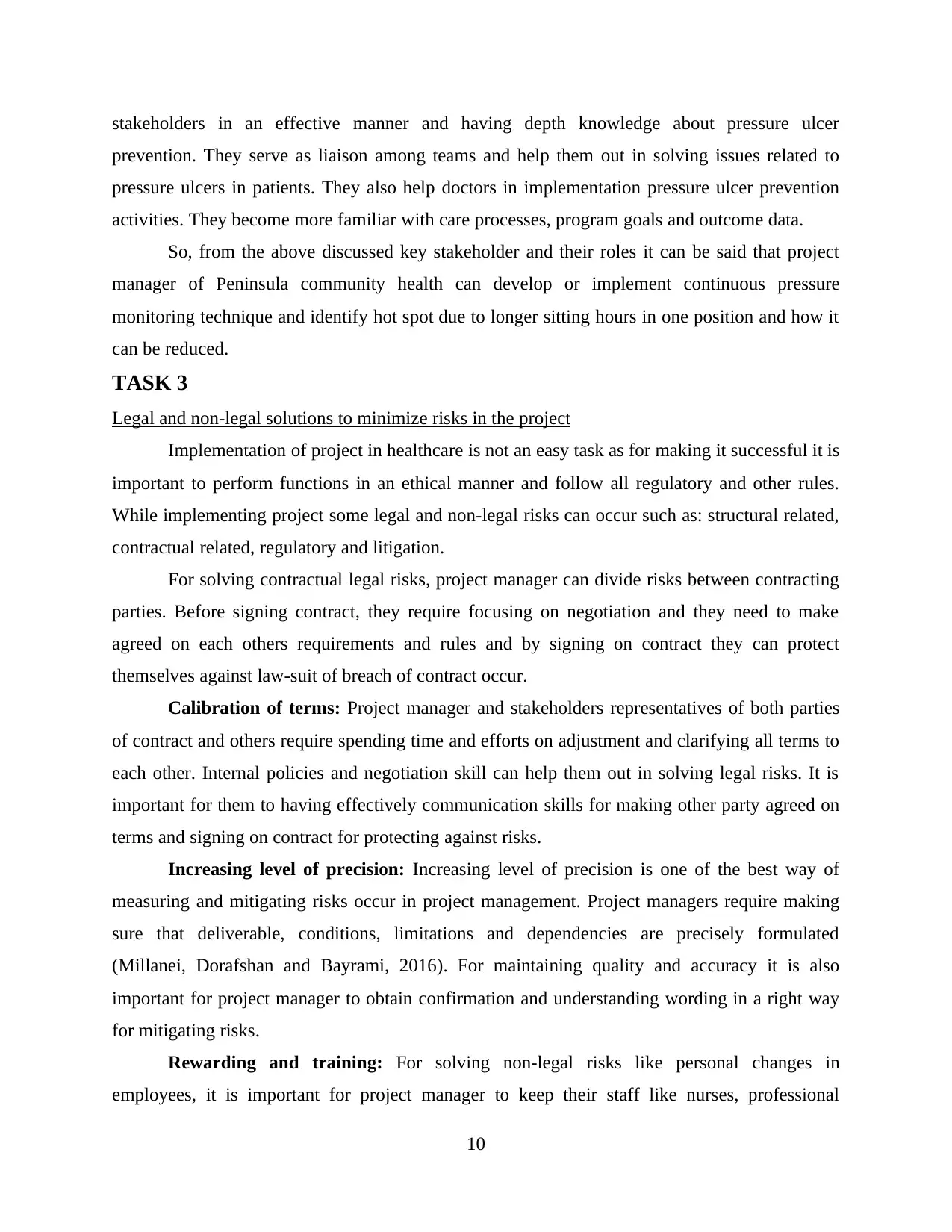
stakeholders in an effective manner and having depth knowledge about pressure ulcer
prevention. They serve as liaison among teams and help them out in solving issues related to
pressure ulcers in patients. They also help doctors in implementation pressure ulcer prevention
activities. They become more familiar with care processes, program goals and outcome data.
So, from the above discussed key stakeholder and their roles it can be said that project
manager of Peninsula community health can develop or implement continuous pressure
monitoring technique and identify hot spot due to longer sitting hours in one position and how it
can be reduced.
TASK 3
Legal and non-legal solutions to minimize risks in the project
Implementation of project in healthcare is not an easy task as for making it successful it is
important to perform functions in an ethical manner and follow all regulatory and other rules.
While implementing project some legal and non-legal risks can occur such as: structural related,
contractual related, regulatory and litigation.
For solving contractual legal risks, project manager can divide risks between contracting
parties. Before signing contract, they require focusing on negotiation and they need to make
agreed on each others requirements and rules and by signing on contract they can protect
themselves against law-suit of breach of contract occur.
Calibration of terms: Project manager and stakeholders representatives of both parties
of contract and others require spending time and efforts on adjustment and clarifying all terms to
each other. Internal policies and negotiation skill can help them out in solving legal risks. It is
important for them to having effectively communication skills for making other party agreed on
terms and signing on contract for protecting against risks.
Increasing level of precision: Increasing level of precision is one of the best way of
measuring and mitigating risks occur in project management. Project managers require making
sure that deliverable, conditions, limitations and dependencies are precisely formulated
(Millanei, Dorafshan and Bayrami, 2016). For maintaining quality and accuracy it is also
important for project manager to obtain confirmation and understanding wording in a right way
for mitigating risks.
Rewarding and training: For solving non-legal risks like personal changes in
employees, it is important for project manager to keep their staff like nurses, professional
10
prevention. They serve as liaison among teams and help them out in solving issues related to
pressure ulcers in patients. They also help doctors in implementation pressure ulcer prevention
activities. They become more familiar with care processes, program goals and outcome data.
So, from the above discussed key stakeholder and their roles it can be said that project
manager of Peninsula community health can develop or implement continuous pressure
monitoring technique and identify hot spot due to longer sitting hours in one position and how it
can be reduced.
TASK 3
Legal and non-legal solutions to minimize risks in the project
Implementation of project in healthcare is not an easy task as for making it successful it is
important to perform functions in an ethical manner and follow all regulatory and other rules.
While implementing project some legal and non-legal risks can occur such as: structural related,
contractual related, regulatory and litigation.
For solving contractual legal risks, project manager can divide risks between contracting
parties. Before signing contract, they require focusing on negotiation and they need to make
agreed on each others requirements and rules and by signing on contract they can protect
themselves against law-suit of breach of contract occur.
Calibration of terms: Project manager and stakeholders representatives of both parties
of contract and others require spending time and efforts on adjustment and clarifying all terms to
each other. Internal policies and negotiation skill can help them out in solving legal risks. It is
important for them to having effectively communication skills for making other party agreed on
terms and signing on contract for protecting against risks.
Increasing level of precision: Increasing level of precision is one of the best way of
measuring and mitigating risks occur in project management. Project managers require making
sure that deliverable, conditions, limitations and dependencies are precisely formulated
(Millanei, Dorafshan and Bayrami, 2016). For maintaining quality and accuracy it is also
important for project manager to obtain confirmation and understanding wording in a right way
for mitigating risks.
Rewarding and training: For solving non-legal risks like personal changes in
employees, it is important for project manager to keep their staff like nurses, professional
10
Paraphrase This Document
Need a fresh take? Get an instant paraphrase of this document with our AI Paraphraser
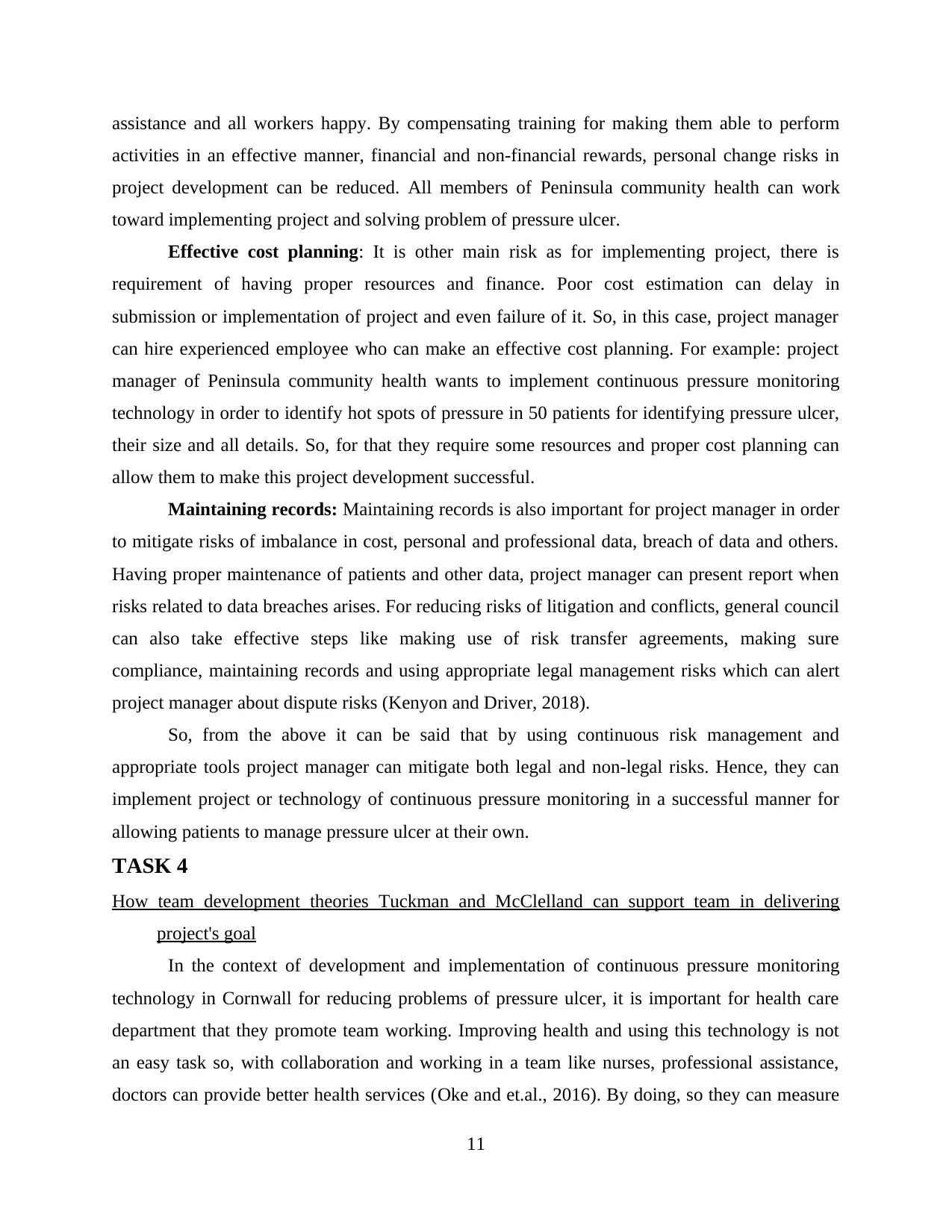
assistance and all workers happy. By compensating training for making them able to perform
activities in an effective manner, financial and non-financial rewards, personal change risks in
project development can be reduced. All members of Peninsula community health can work
toward implementing project and solving problem of pressure ulcer.
Effective cost planning: It is other main risk as for implementing project, there is
requirement of having proper resources and finance. Poor cost estimation can delay in
submission or implementation of project and even failure of it. So, in this case, project manager
can hire experienced employee who can make an effective cost planning. For example: project
manager of Peninsula community health wants to implement continuous pressure monitoring
technology in order to identify hot spots of pressure in 50 patients for identifying pressure ulcer,
their size and all details. So, for that they require some resources and proper cost planning can
allow them to make this project development successful.
Maintaining records: Maintaining records is also important for project manager in order
to mitigate risks of imbalance in cost, personal and professional data, breach of data and others.
Having proper maintenance of patients and other data, project manager can present report when
risks related to data breaches arises. For reducing risks of litigation and conflicts, general council
can also take effective steps like making use of risk transfer agreements, making sure
compliance, maintaining records and using appropriate legal management risks which can alert
project manager about dispute risks (Kenyon and Driver, 2018).
So, from the above it can be said that by using continuous risk management and
appropriate tools project manager can mitigate both legal and non-legal risks. Hence, they can
implement project or technology of continuous pressure monitoring in a successful manner for
allowing patients to manage pressure ulcer at their own.
TASK 4
How team development theories Tuckman and McClelland can support team in delivering
project's goal
In the context of development and implementation of continuous pressure monitoring
technology in Cornwall for reducing problems of pressure ulcer, it is important for health care
department that they promote team working. Improving health and using this technology is not
an easy task so, with collaboration and working in a team like nurses, professional assistance,
doctors can provide better health services (Oke and et.al., 2016). By doing, so they can measure
11
activities in an effective manner, financial and non-financial rewards, personal change risks in
project development can be reduced. All members of Peninsula community health can work
toward implementing project and solving problem of pressure ulcer.
Effective cost planning: It is other main risk as for implementing project, there is
requirement of having proper resources and finance. Poor cost estimation can delay in
submission or implementation of project and even failure of it. So, in this case, project manager
can hire experienced employee who can make an effective cost planning. For example: project
manager of Peninsula community health wants to implement continuous pressure monitoring
technology in order to identify hot spots of pressure in 50 patients for identifying pressure ulcer,
their size and all details. So, for that they require some resources and proper cost planning can
allow them to make this project development successful.
Maintaining records: Maintaining records is also important for project manager in order
to mitigate risks of imbalance in cost, personal and professional data, breach of data and others.
Having proper maintenance of patients and other data, project manager can present report when
risks related to data breaches arises. For reducing risks of litigation and conflicts, general council
can also take effective steps like making use of risk transfer agreements, making sure
compliance, maintaining records and using appropriate legal management risks which can alert
project manager about dispute risks (Kenyon and Driver, 2018).
So, from the above it can be said that by using continuous risk management and
appropriate tools project manager can mitigate both legal and non-legal risks. Hence, they can
implement project or technology of continuous pressure monitoring in a successful manner for
allowing patients to manage pressure ulcer at their own.
TASK 4
How team development theories Tuckman and McClelland can support team in delivering
project's goal
In the context of development and implementation of continuous pressure monitoring
technology in Cornwall for reducing problems of pressure ulcer, it is important for health care
department that they promote team working. Improving health and using this technology is not
an easy task so, with collaboration and working in a team like nurses, professional assistance,
doctors can provide better health services (Oke and et.al., 2016). By doing, so they can measure
11
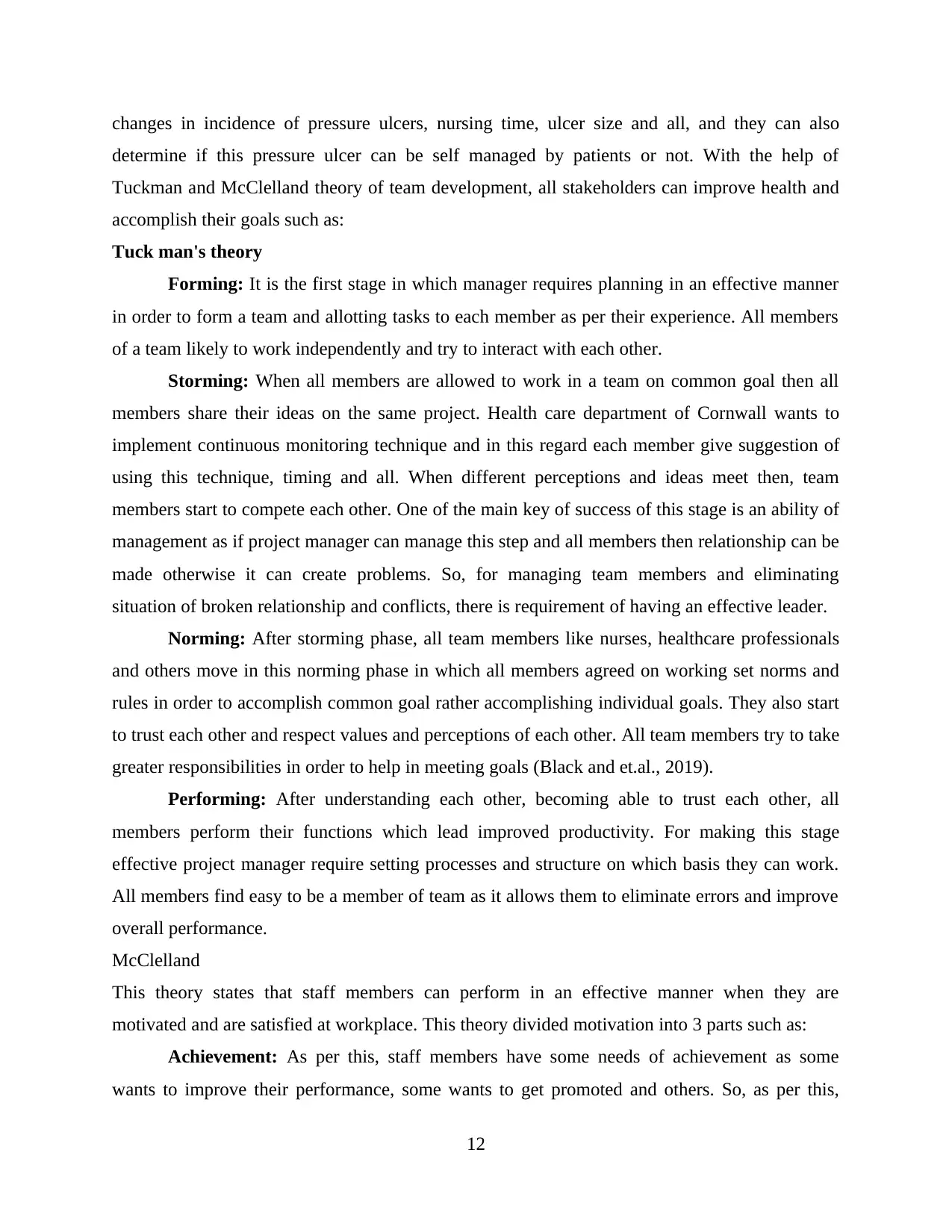
changes in incidence of pressure ulcers, nursing time, ulcer size and all, and they can also
determine if this pressure ulcer can be self managed by patients or not. With the help of
Tuckman and McClelland theory of team development, all stakeholders can improve health and
accomplish their goals such as:
Tuck man's theory
Forming: It is the first stage in which manager requires planning in an effective manner
in order to form a team and allotting tasks to each member as per their experience. All members
of a team likely to work independently and try to interact with each other.
Storming: When all members are allowed to work in a team on common goal then all
members share their ideas on the same project. Health care department of Cornwall wants to
implement continuous monitoring technique and in this regard each member give suggestion of
using this technique, timing and all. When different perceptions and ideas meet then, team
members start to compete each other. One of the main key of success of this stage is an ability of
management as if project manager can manage this step and all members then relationship can be
made otherwise it can create problems. So, for managing team members and eliminating
situation of broken relationship and conflicts, there is requirement of having an effective leader.
Norming: After storming phase, all team members like nurses, healthcare professionals
and others move in this norming phase in which all members agreed on working set norms and
rules in order to accomplish common goal rather accomplishing individual goals. They also start
to trust each other and respect values and perceptions of each other. All team members try to take
greater responsibilities in order to help in meeting goals (Black and et.al., 2019).
Performing: After understanding each other, becoming able to trust each other, all
members perform their functions which lead improved productivity. For making this stage
effective project manager require setting processes and structure on which basis they can work.
All members find easy to be a member of team as it allows them to eliminate errors and improve
overall performance.
McClelland
This theory states that staff members can perform in an effective manner when they are
motivated and are satisfied at workplace. This theory divided motivation into 3 parts such as:
Achievement: As per this, staff members have some needs of achievement as some
wants to improve their performance, some wants to get promoted and others. So, as per this,
12
determine if this pressure ulcer can be self managed by patients or not. With the help of
Tuckman and McClelland theory of team development, all stakeholders can improve health and
accomplish their goals such as:
Tuck man's theory
Forming: It is the first stage in which manager requires planning in an effective manner
in order to form a team and allotting tasks to each member as per their experience. All members
of a team likely to work independently and try to interact with each other.
Storming: When all members are allowed to work in a team on common goal then all
members share their ideas on the same project. Health care department of Cornwall wants to
implement continuous monitoring technique and in this regard each member give suggestion of
using this technique, timing and all. When different perceptions and ideas meet then, team
members start to compete each other. One of the main key of success of this stage is an ability of
management as if project manager can manage this step and all members then relationship can be
made otherwise it can create problems. So, for managing team members and eliminating
situation of broken relationship and conflicts, there is requirement of having an effective leader.
Norming: After storming phase, all team members like nurses, healthcare professionals
and others move in this norming phase in which all members agreed on working set norms and
rules in order to accomplish common goal rather accomplishing individual goals. They also start
to trust each other and respect values and perceptions of each other. All team members try to take
greater responsibilities in order to help in meeting goals (Black and et.al., 2019).
Performing: After understanding each other, becoming able to trust each other, all
members perform their functions which lead improved productivity. For making this stage
effective project manager require setting processes and structure on which basis they can work.
All members find easy to be a member of team as it allows them to eliminate errors and improve
overall performance.
McClelland
This theory states that staff members can perform in an effective manner when they are
motivated and are satisfied at workplace. This theory divided motivation into 3 parts such as:
Achievement: As per this, staff members have some needs of achievement as some
wants to improve their performance, some wants to get promoted and others. So, as per this,
12
⊘ This is a preview!⊘
Do you want full access?
Subscribe today to unlock all pages.

Trusted by 1+ million students worldwide
1 out of 16
Related Documents
Your All-in-One AI-Powered Toolkit for Academic Success.
+13062052269
info@desklib.com
Available 24*7 on WhatsApp / Email
![[object Object]](/_next/static/media/star-bottom.7253800d.svg)
Unlock your academic potential
Copyright © 2020–2025 A2Z Services. All Rights Reserved. Developed and managed by ZUCOL.





